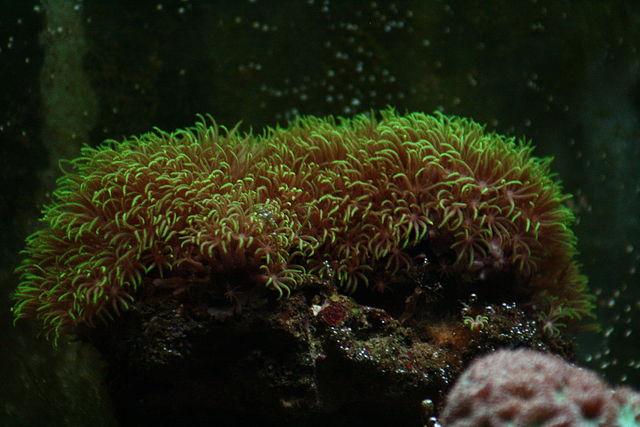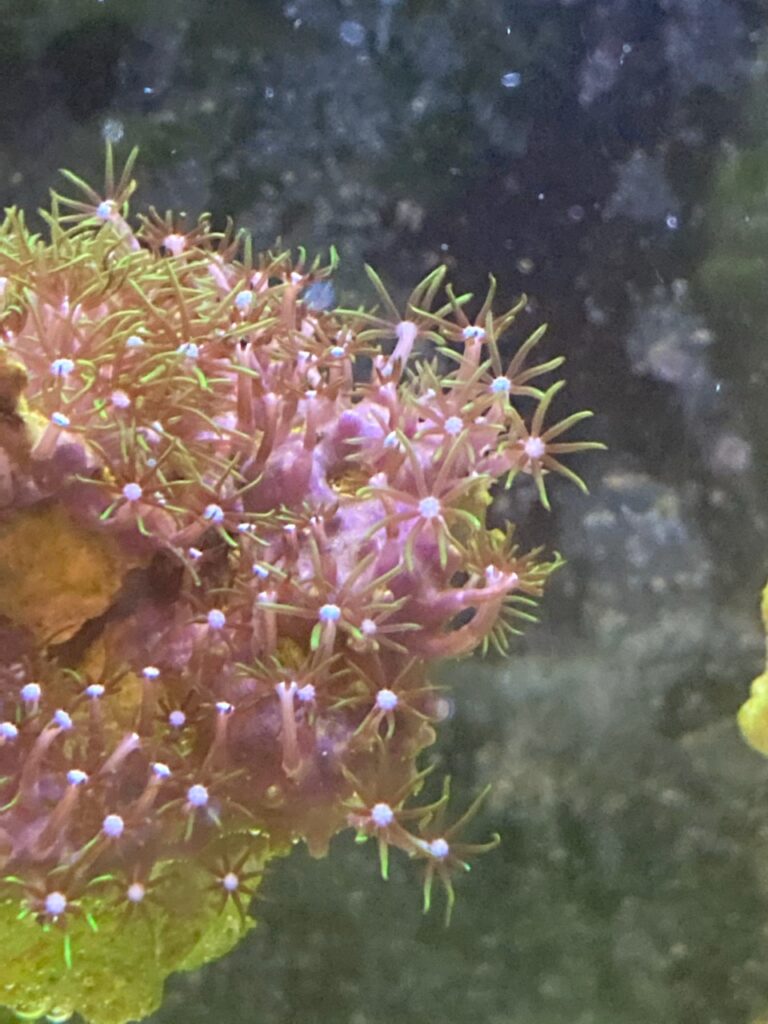
Green Star Polyps are an excellent soft coral, especially for beginners. They provide color and movement to your saltwater tank. In addition, they are hardy and can tolerate a range of water parameters that some more sensitive corals may not be able to do well in. This is fairly standard for a lot of soft corals as well.
They are peaceful and will not attack other corals, but if they grow close to aggressive species, they can be attacked.
It is an encrusting species and will cover just about anything that you stick them too. They are so proficient at covering things and growing that many hobbyist consider them to be an invasive species of coral. They can get out of hand in your tank if you don’t take care or them and cut them back. They also can grow wild if you don’t choose the best placement for them.
That should not deter you from considering this soft coral for your tank because with proper care they can be managed well, and their fast growth rate can be controlled and directed. We will discuss some ways to properly care for green star polyps so that they do not become a nuisance in your reef tank.
These are great soft corals, and once you get an established colony, they will look like a field of green grass flowing in your saltwater reef tank. We will look at some helpful tips, and some information on how to care for green star polyps so that they grow in your tank.
GSP Care Highlights
- Needs medium to high flow
- Low to moderate lighting
- Care Level: Easy
- pH: 8.1-8.4
- Temperature: 72-78 degrees F
- Color: Green
- Beginner Friendly
- Placement: Middle to Top
- Fast Growing
- Peaceful
Taxonomy

Green Star Polyps are known as (Briareum sp.) or (Clavularia viridis.) They also have multiple common names such as Daisy Polyps and Starburst Polyp.
- Family: Briareidae
- Location: Indo-Pacific
- Coral Type: Soft
Each polyp has 8 green tentacles, and these would be considered colonial because many polyps will grow together in their environment.
Best Placement
The great thing about green star polyps is how they can be used in your aquarium. They prefer to have moderate flow, and you should see their polyps swaying in the tank. If they are in a stagnant area of your tank, they may not open or grow well.
The most common place for them is on live rock. Over time, they will take over the rock and cover it completely. It is best to create an island to grow green star polyps on. To do this, just have a rock that is isolated and not touching anything else. This way, it won’t grow on connecting rocks. Once it does this, it is hard to remove.
Over time, it will grow away from the rock onto the glass or sand bed. This is easy to notice, and it is also easy to remove. You can then use the extra for other tanks or for other places in your its current environment. You can also trade in coral frags to your loca fish store. This means that you can get more stuff for free, and who doesn’ like that!
In addition to rock placement, a lot of hobbyist will use these corals as a green carpet. You can take a frag and place it on your tank bottom, and it will cover the bottom over time. Remember though, that anything that is touching the bottom will get covered in gsp over time. This can be done on the sand bed or the glass bottom.
Another common placement for GSP is the sides and back of the aquarium. Some people don’t like dealing with algae on their glass, and this provides a way to avoid that. Plus, it looks cool to have a living organism covering the back or sides of your tank.
Lighting
Almost any reef light will work for GSP’s, and they can also live under low end lights that you get from a big box store, but the best lights that showcase them are LED lights. We use AI Prime reef lights on our tanks, but Kessil also makes a great light.
You don’t have to use LED’s. Any reef light such as T5 will work, but we love the colors that an LED will provide.
Almost any reasonable PAR reading will work, and like we said, even low quality lights will get the polyps to open up. Granted, you might not get the best growth rate with a low end light, and we certainly don’t recommend those.
If they are exposed to too much light, they will close up, and they should open again once they are in a more suitable area.
Feeding Green Star Polyps
These corals do not need to be fed, and they will grow fast without feeding. GSP get their energy from zooxanthellae that live in their tissue. Zooxanthellae is a photosynthetic algae that forms a symbiotic relationship with corals, and they provide energy and waste removal for corals in exchange for housing and protection.
These corals grow very fast under reef lights, and some people consider it an invasive species because it grows so fast. If you want it to grow faster, you can feed it something like Reef Roids.
How To Frag A Green Star Polyp
Green Star Polyps are an encrusting coral, and they basically cover whatever you put them on. This includes glass, rocks, pipes, sand, etc.
These are one of the easiest corals to frag because all you need to do it tear their mat. You do do this with your hands, scissors, a credit card, a drivers license, or a knife.
The proper way to frag GSP’s is to remove the colony from your aquarium, cut off a piece that will fit on a frag plug, and then glue it to the plug with cyanoacrylate (super glue.)
It won’t hurt to put it in a coral dip to make sure any pests are removed before placing it into a new tank.
F.A.Q
The best method that I have seen to get rid of GSP is to use an old credit card to scrape them off the glass.
The best way to get GSP off of rock is to manually peel them and then use a chisel to remove a bit of the rock. It is difficult to get them all off because even if you leave one polyp, then will grow back.
Green star polyps get their energy from light, but if you want them to grow faster, then you can feed them something like Reef Roids.
Summary On GSP Care
Green Star Polyps are great corals, but they are not for everyone. They are easy to care for, and they are hardy. The down side for some reefers is their fast growth rate which can take over a tank if you don’t care of it. The level of work to keep them manageable is not very much though. These beginner friendly corals are excellent for new hobbyist and experienced reefers. They are a great way to add color and movement to your saltwater aquarium
They aren’t going to overtake your tank in a few days. It is going to take months for them to do that, and you can easily cut off and remove what you don’t want.
The best way to handle these corals is to place them on an isolated area like a rock and allow them to grow there. This way you can enjoy them, but you don’t have to worry about them spreading to other parts of your aquarium.
featured image via: PilarMeca, CC BY-SA 3.0 https://creativecommons.org/licenses/by-sa/3.0, via Wikimedia Commons
